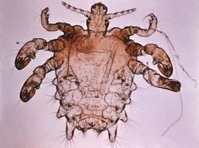Pubic lice
Crab lice (singular, louse), scientific name Phthirus pubis and commonly called "crabs" due to their resemblence to the crab, are one of three kinds of human lice in the large group of lice families, the others being head lice and body lice, which live in clothing. more...
They are wingless, about 1 to 3 mm long. They attach themselves to hair strands, and hatch out of pods with lids, or "nits", that are too tightly attached to be brushed off but must be removed by pulling with the nails or a fine-toothed comb.
General information
The crab louse can live in almost any form of humanoid hair, but is found most commonly in pubic hair, leading to its other common name of pubic louse. Its legs are adapted to climbing along relatively widely spaced hairs, and so can be found in eyelashes, pubic hair, beards, moustaches, and even armpit hairs. The individual louse can survive up to a week apart from its necessary human host, so that crab lice can be passed on in sleeping bags and bedding. The female may lay up to 40 eggs a time, resulting in a fluctuating but growing population. The louse feeds on blood and can leave irritating spots on the skin, sometimes mistaken for pimples, a condition called Pediculosis pubis.
Pubic lice have legs that are spaced further apart than head lice, this is an adaptation that enables them to move around more easily in their habitat.
The female louse glues her eggs, called "nits", which look like tiny white beads, to hair shafts. Lice bite through the skin to suck blood, and the bite causes itching. Bites can become secondarily infected; scratching may break the skin and help cause secondary infection. The most common symptom of crab lice is itching of genital area.
Pubic lice are normally spread by sexual contact and are considered a sexually transmitted disease, but can also be spread by sharing clothes or bedding. A common misbelief is that infestation can be spread by sitting on a toilet seat. This is not likely since lice cannot live long away from a warm human body. Also, lice do not have feet designed to walk or hold onto smooth surfaces such as toilet seats.
Life cycle
There are three stages in the life of a pubic louse: the nit, the nymph, and the adult.
- Nit: Nits are pubic lice eggs. They are hard to see and are found firmly attached to the hair shaft. They are oval and usually yellow to white. Nits take about 1 week to hatch.
- Nymph: The nit hatches into a baby louse called a nymph. It looks like an adult pubic louse, but is smaller. Nymphs mature into adults about 7 days after hatching. To live, the nymph must feed on blood.
- Adult: The adult pubic louse resembles a miniature crab when viewed through a strong magnifying glass. Pubic lice have six legs, but their two front legs are very large and look like the pincher claws of a crab; this how they got the nickname "crabs." Pubic lice are tan to greyish-white in color. Females lay nits; they are usually larger than males. To live, adult lice need to feed on blood. If the louse falls off a person, it dies within 1-2 days.
Read more at Wikipedia.org



